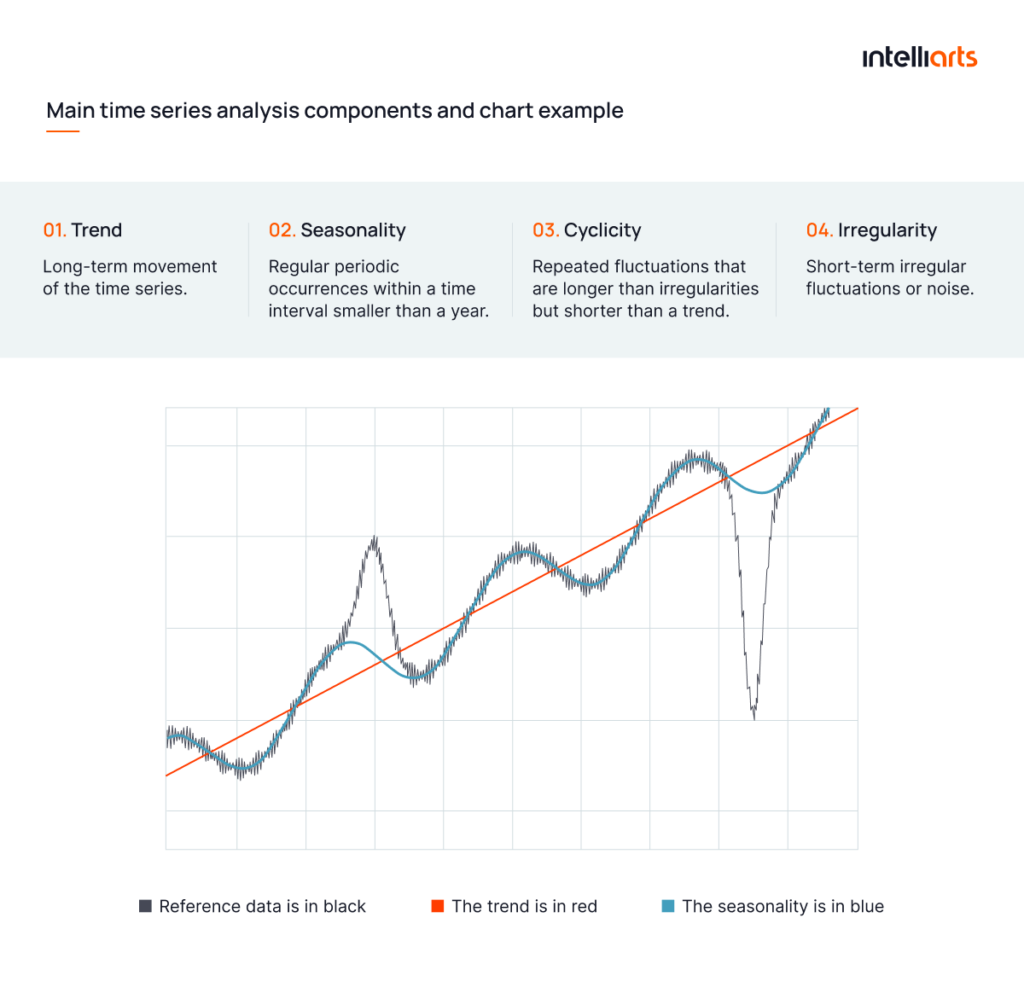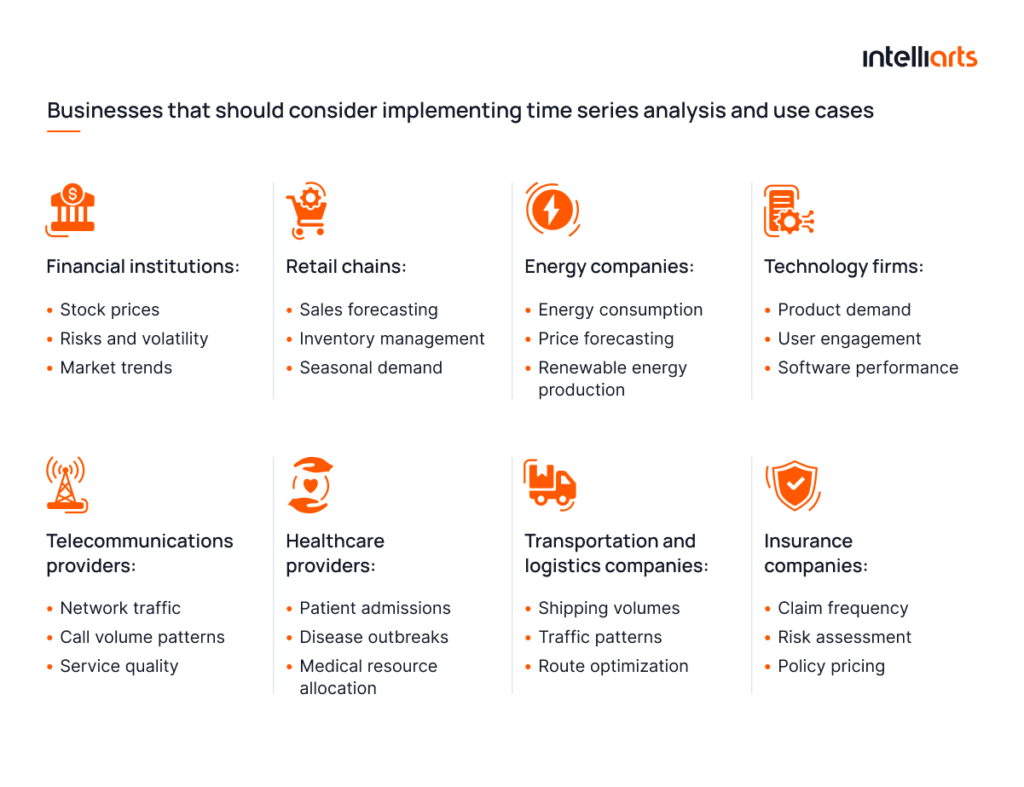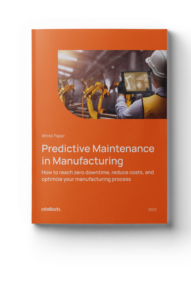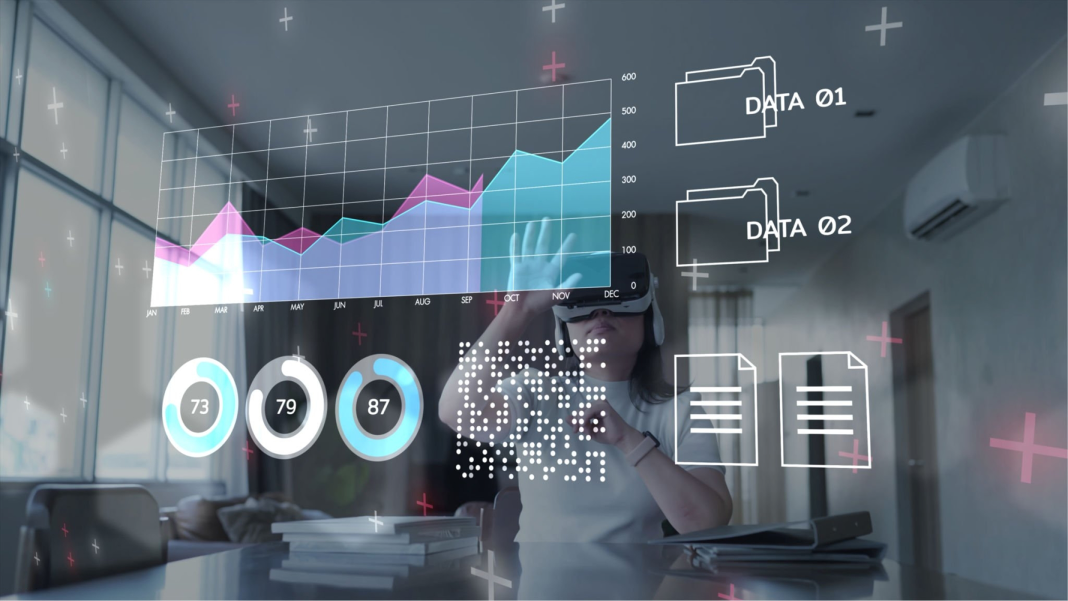The value of business analytics has hardly ever been underestimated. Time series analysis, covering trends that can be spotted over time, is one of the widespread ways to analyze and make use of vast business data that companies gather during their daily operations.
Valued at $18.9 billion, the Analytics-as-a-Service (AaaS) market, which also covers forms of time series analysis distributed as services, is projected to rise to $58 billion by the year 2027. It clearly shows the rising popularity of analytics in business, conducted by both external and in-house means.
In this post, you’ll discover about time series analysis, its components, a time series chart, and time series models. You’ll also review six top use cases of utilizing time series analysis in businesses by famous companies.
What is time series analysis
Time series analysis is a statistical technique used to analyze time-ordered data points to identify patterns, trends, and relationships over time.
Here’s how the Intelliarts ML expert Volodymyr Mudryi defines time series analysis:
“Time series analysis involves collecting and analyzing data at regular intervals to forecast future values, understand underlying trends, seasonality, and cyclic patterns, and make informed decisions based on historical observations.”
The key components of time series analysis are:
- Trend. Long-term movement of the time series. An example is the increase in the number of mobile payment transactions as more consumers adopt digital payment methods.
- Seasonality. Regular periodic occurrences within a time interval smaller than a year. An example is seasonal demand for certain products, such as higher production of air conditioners in the lead-up to summer.
- Cyclicity. Repeated fluctuations around the trend that are longer in duration than irregularities but shorter than what would constitute a trend. An example is fluctuations in trading volumes corresponding to quarterly earnings reports or macroeconomic events.
- Irregularity. Short-term irregular fluctuations or noise. An example is an unplanned production stoppage due to equipment breakdowns or supply chain disruption.
You can familiarize yourself with an example of what a two-year time series analysis can look like in the chart below:

Source: Timescale.com
In the infographic, the reference data is colored black, the trend is colored red, and the seasonality is colored blue. You can observe cyclic fluctuations, and two large irregularities complete the decomposition. This graphic can be typical for the demand for seasonal goods and products, such as clothing.
If you’re interested in time series analysis, you may equally be interested in exploring strategies to use data science for business.
You can discover more about what time series analysis is in the video below:
Time series analysis models
You may wonder what statistical tools used to analyze and forecast time-ordered data are there. Known as time series analysis models, common analytical solutions to use as basic for an analytical system include the following:
1. ARIMA (Autoregressive Integrated Moving Average)
Key principles: Combines autoregressive (AR) and moving average (MA) models with differencing to make the time series stationary. It is characterized by three parameters: p (autoregressive order), d (degree of differencing), and q (moving average order).
Application: Univariate time series with trend and without seasonal components.
2. SARIMA (Seasonal ARIMA)
Key principles: Extends ARIMA by adding seasonal terms to handle seasonality in the data. It includes additional seasonal parameters: P (seasonal autoregressive order), D (seasonal differencing degree), Q (seasonal moving average order), and s (seasonal period).
Application: Time series with both trend and seasonality
3. Holt-Winters (Exponential Smoothing)
Key principles: Applies exponential smoothing to capture level, trend, and seasonal components in data. It uses three smoothing parameters: α (level), β (trend), and γ (seasonality).
Application: Time series with trend and seasonality, especially when the data is relatively stable and the seasonal pattern is consistent.
4. VAR (Vector Autoregression)
Key principles: A multivariate extension of the AR model, capturing the linear interdependencies among multiple time series.
Each variable is modeled as a linear combination of its own past values and the past values of other variables.
Application: Multivariate time series analysis, such as analyzing the relationship between economic indicators.
5. GARCH (Generalized Autoregressive Conditional Heteroskedasticity)
Key principles: Models the conditional variance (volatility) of a time series as a function of its own past values and past variances. It is characterized by parameters p (order of the autoregressive term) and q (order of the moving average term).
Application: Financial time series with volatility clustering.
These methodologies used in time series analysis can be applied simultaneously to provide several outcomes that will verify each other’s correctness and provide a broader picture.
Note: As with most other analytical methods, the use of any time series model can be automated. They can also be greatly enhanced by the involvement of ML-based algorithms that will help:
- Make the data for analysis uniform
- Cleanse data
- Help to make insights based on time series analysis results
Are you looking for a trusted provider to help you implement an ML-based time series analysis solution for your business? Drop Intelliarts a line, and let’s discuss opportunities.
What businesses should consider implementing time series analysis models and why
As a manager, business strategist, or data scientist, you likely aim to determine whether time series analysis can be a valuable addition to your current analytical measures and strategic planning flow. Well, let’s take a look at some of the business types that often implement time series analysis and corresponding use cases in the infographic below:

- Improved forecasting accuracy: Performing time series analysis enables more accurate predictions of future trends, enhancing decision-making.
- Enhanced risk management: It helps assess and mitigate risks by predicting market fluctuations in sectors like finance.
- Optimized inventory management: Retailers can anticipate demand, reducing stockouts and excess inventory and saving costs.
- Efficient resource allocation: Energy companies can forecast consumption patterns, ensuring a balance between supply and demand.
- Data-driven decision-making: Provides insights into trends, enabling informed strategic decisions based on empirical evidence.
Basically, this form of analysis can be advantageous in numerous ways, offering a competitive advantage to many digital and offline companies.
If you’re exploring how to make use of business data, you’ll likely be interested in another Intelliarts blog post on the topic of how big data and AI work together.
Time series analysis: 6 usage examples
It’s always great to have solid examples of well-established businesses successfully using one or another technology, to see how it can potentially work in practice. Let’s review six top time series analysis cases of companies operating across different business domains:
#1 Time Series in the Electronic Interconnect Industry: Case of a manufacturing company
The Intelliarts’ customer is a service provider in the electronic interconnect industry, known for manufacturing and distributing connectors, cables, optics, and more.
Case description: The company faces challenges in predicting demand and improving stock availability. To address this, the company collaborated with the Intelliarts ML team to develop a machine learning prediction and forecasting engine. This engine is designed to detect patterns in the manufacturer’s data and make accurate sales predictions, aiding in procurement forecasts.
Case outcomes: The implementation of this machine learning model has enabled Intelliarts’ customer to anticipate future purchasing needs, manage resources more efficiently, and reduce costs and waste, leading to improved operational efficiency.
#2 Time series in the financial sector: Case of Goldman Sachs
Goldman Sachs is a leading global investment banking, securities, and investment management firm. It’s known for its expertise in market risk management.
Case description: Goldman Sachs employs time series analysis in market risk management, particularly for Value at Risk (VaR) modeling, which estimates potential portfolio losses. his approach enables Goldman Sachs to quantify the level of financial risk associated with their investment portfolios and make informed decisions to mitigate potential losses.
Case outcomes: The use of time series analysis enables Goldman Sachs to better manage market risk and make informed investment decisions. The firm’s VaR modeling has been noted to average record levels, highlighting its significance in its risk management strategy.
#3 Time series in the retail sector: Case of Walmart
Walmart is the world’s largest retail corporation, offering an extensive range of products, including groceries, apparel, electronics, and home goods.
Case description: Walmart employs time series analysis for demand forecasting and inventory management. By analyzing historical sales data, Walmart can anticipate future demand trends for various products and adjust its inventory accordingly.
Case outcomes: The application of time series analysis in Walmart’s operations has led to significant improvements in supply chain efficiency and inventory management. By maintaining optimal stock levels and reducing the likelihood of stockouts, Walmart enhances customer satisfaction.
#4 Time series in the energy sector: Case of National Grid
National Grid is an electricity and gas utility company responsible for energy transmission and distribution.
Case description: National Grid applies time series analysis for electricity demand forecasting, crucial for grid stability and energy distribution planning. By predicting the electricity demand, National Grid can ensure that there is a sufficient supply of energy to meet the needs of consumers and businesses.
Case outcomes: Enhanced grid stability and optimized energy distribution achieved through the application of time series analysis ensure reliable electricity supply preventing blackouts.
#5 Time series in the technology sector: Case of Netflix
Netflix is a popular streaming service that offers a wide variety of TV shows, movies, and documentaries.
Case description: Netflix uses time series analysis to predict user engagement and content popularity, which are key factors in its content recommendation algorithm and strategic decision-making. By analyzing viewing patterns and trends, Netflix can tailor its recommendations to individual users.
Case outcomes: The data-driven approach has been useful in driving the company’s subscriber growth and retention.
#6 Time series in the telecommunications sector: Case of AT&T
AT&T is a telecommunications company providing a range of services, including wireless and wired internet, TV, and phone services.
Case description: AT&T employs time series analysis for network traffic forecasting, aiding in capacity planning and quality of service maintenance. By predicting the volume of data traffic on its network, AT&T can allocate resources efficiently, ensuring that its infrastructure can handle peak demand periods without compromising service quality.
Case outcomes: The proactive approach allows for enhanced network capacity planning and service quality, leading to improved customer satisfaction.
Final take
Time series analysis is a powerful statistical tool used to forecast future trends, manage risks, optimize inventory, and enhance decision-making. By leveraging time series models, businesses can gain insights into patterns and seasonality in their data, leading to improved operational efficiency and competitive advantage. Implementing time series analysis, especially with AI enhancements, can significantly benefit companies in finance, retail, energy, technology, and telecommunications.
Implementing a time series solution in business, automating it, and enhancing it with AI capabilities, require substantial experience and expertise. The right call is to entrust your project to qualified engineers. Consider Intelliarts, a development firm with over 24 years of experience delivering cutting-edge and data-driven software solutions, your primary choice in this regard.
FAQ
The main objectives of time series analysis are to understand the underlying structure and behavior of data, identify patterns such as trends and seasonality, forecast future values, and make informed decisions based on the analysis.
Time series forecasting is a statistical technique used to predict future values based on previously observed values. It involves analyzing time series data to identify patterns and trends, which are then used to forecast future data points.
Time series analysis helps in modeling and forecasting market volatility. By analyzing historical financial data, firms can identify potential risks and devise strategies to mitigate them, ensuring more stable financial performance.









